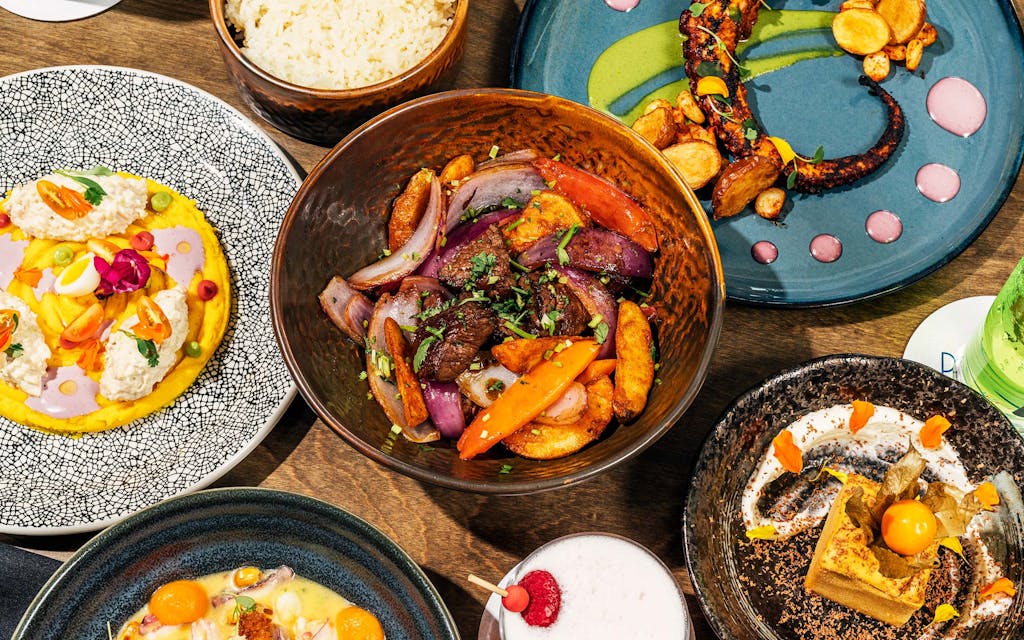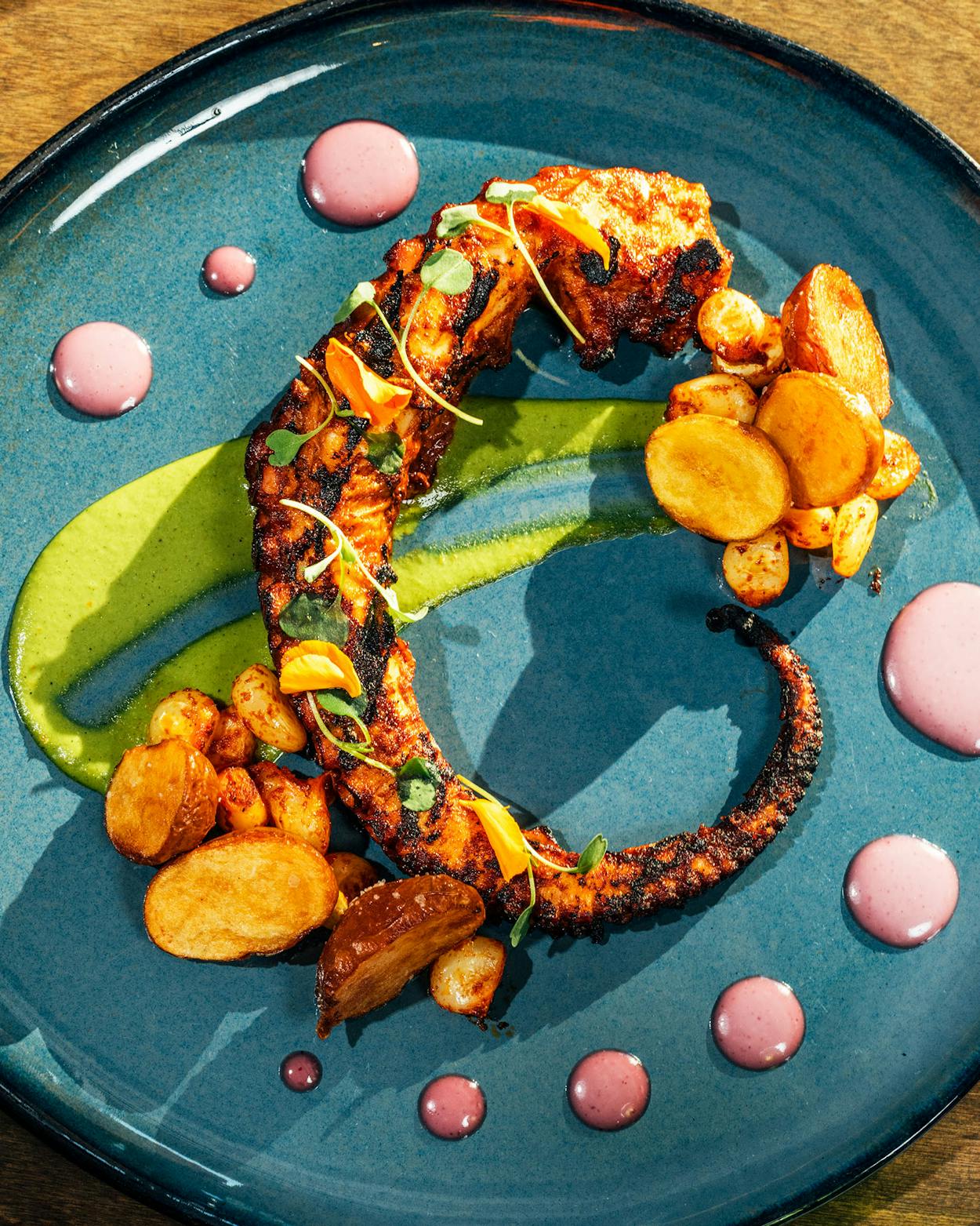Never before had I seen a more gorgeous presentation of mashed potatoes. The creamy spuds had been piped in concentric circles until they almost covered a striking black-and-white, crackle-patterned plate. Mild South American ajis amarillos, or yellow chile peppers, gave the potatoes a vivid golden color, and on top were bright pops of red (grape tomatoes), purple (Botija olive aioli), and green (avocado puree), along with a darling half of a soft-boiled quail egg. Oh, and there were generous spoonfuls of chicken salad—I mustn’t forget the chicken salad. The dish itself was a novel version of causa limeña, Peru’s famous cold, layered appetizer, and the place where I was getting ready to eat it was a three-month-old Houston dining venue named Pacha Nikkei. I had expected unusual combinations when I made reservations at the Peruvian-Japanese restaurant. I hadn’t been prepared for edible art.
Pacha Nikkei first caught my eye almost three years ago, when I walked past the counter space it then occupied at Politan Row, a small food hall in Rice Village. By the end of 2020, the COVID-19 pandemic had forced the closure of Politan, but the stall’s chef-owner, Masaru Fukuda, was not deterred. He had taken a big gamble when he left behind a career as a graphic designer to focus on his true love: food. He had learned the business by running a catering company and working at Latin Bites and Kata Robata. He was determined to find another location. He ended up with an ample space in a large strip mall on Westheimer where he could offer quick lunches and creative dinners. True, it was fifteen miles west of downtown. On the other hand, it was less than three miles north of Bellaire Boulevard, the lively commercial street known citywide as a destination for connoisseurs of Asian cuisines.

Peru, which is almost two times the size of Texas, is one madly swirling melting pot, with a multilayered culinary history that informs both the everyday eateries of its smaller cities and the fine-dining restaurants of its capital, Lima, a metropolis of ten million. For millennia, Indigenous groups (Aymara, Jivaroan, Quechua, and many more) cultivated squash, peanuts, maize, quinoa, ajis, and scores of the continent’s numerous knobby native potatoes. For meat, they raised llamas and guinea pigs and fished the coast’s inlets and bays. The arrival in the sixteenth century of the Spanish—accompanied by enslaved Africans—augmented the local diet with imports such as pigs, cattle, wheat, sugarcane, and grapes.
Following Peru’s declaration of independence, in 1821, and the abolition of slavery, in 1854, the country began to attract immigrants from across Europe and Asia, who came to work in the growing country’s farming and construction sectors. Fukuda’s own great-grandfather joined the Nikkei community in the 1920s, after emigrating from Japan (“Nikkei” refers to Japanese people living outside the home country). Fukuda, a fourth-generation Nikkei Peruvian who moved with his parents to New York when he was thirteen, says the family straddled two worlds. “We spoke Spanish at home,” remembers the forty-year-old, “but we said things like ‘good night’ and ‘thank you’ to each other in Japanese.”
Should you decide to give Pacha Nikkei a try—and you definitely should—I have a suggestion for your first course: one of the country’s beloved ceviches, specifically Fukuda’s take on ceviche chalaco (Spanish for a resident of the Peruvian port city Callao). It starts with creamy-looking leche de tigre pumped up with fresh lime, garlic, ginger, and aji amarillo; a shot of umami-rich dashi gives it a Japanese touch. Assorted shellfish and tidy sliced fish marinate ever so briefly in this tart brew, and the whole combination is prettily topped with strips of panko-coated fried cuttlefish, chewy choclo (giant-kernel Peruvian corn), and a puree of sweet potato. The carnival of flavors works brilliantly.


If you want to stay with seafood, consider the sushi rolls, of which there are seven options on the frequently changing menu. The Pacha is served uramaki-style, with the rice on the outside, bolstered with slices of rosy-hued tuna, avocado, shiso leaf, and a shower of bonito flakes.
Perhaps, though, you’re in the mood for something simpler. In that case, go for the superlatively tender pulpo (octopus). The leggy critter is braised and grilled, then presented with a green swath of huacatay sauce (made from basil-like Peruvian black mint) and more of the purple Botija olive aioli.
At some point, take a little breather and look around at the dining room’s engaging decor and art, all of it curated by Fukuda. On one wall is a mural of a stylized dragon inspired by fantastically costumed folk dancers who perform at traditional festivals held in Peru and other Andean countries. “It’s called La Diablada,” he told me, which means “devils’ dance.” Also depicted in the mural is Lima’s glittering nighttime skyline next to a photo of a serene young woman in a blue kimono (“She’s my cousin,” he said). Finally, gesturing to an image of an older man on another wall, he said, “And that is my great-grandfather.”
Once your seafood exploration is over, you should consider checking out a couple of the meaty options, chief among them the asada de tira, a small plate of grilled, boneless American Wagyu short rib. The meat came glazed in soy, honey, and fruity-tasting aji panca, and it was fantastic. I was equally intrigued by a less mainstream option, the anticuchos de corazón. Yes, friends, tidy bites of skewered beef heart. In Pacha Nikkei’s kitchen the main ingredient of this Peruvian street food is scrupulously prepped and then marinated in a heady brew featuring corn beer, cumin, and oregano. No organ flavor remains, and the medium-rare morsels simply taste like the lean beef they are. A quinoa salad—bright with edamame, grapes, and toasted almonds in a sweet lychee dressing—makes an excellent and arty accompaniment.

No visit to a Peruvian restaurant is complete, however, without an order of the country’s second most popular dish—after ceviche—and that is lomo saltado. The Chinese-Peruvian stir-fry combines marinated tenderloin, purple onion, and big fat french fries with a rich, brown soy-sauce gravy. It is easy to throw together and easy to like, the very definition of comfort food.
If you’re not pleasantly overwhelmed by the time you near the end of your visit, indulge in one of the three desserts. The almond cake arrives under a flutter of flower petals and a layer of guanabana mousse. Another pretty one is an individual dome-shaped chocolate mousse called namelaka (“creamy” in Japanese). But my favorite was the cheesecake made with lucuma, a South American fruit that somehow combines the flavors of maple syrup, caramel, and sweet potato. It was beguiling, familiar and exotic at once, rather like Pacha Nikkei itself.
Pacha Nikkei
10001 Westheimer Rd, Houston
832-834-5697
L Tue–Fri. D Tue–Sat. B Sat & Sun.
$$$
Opened August 12, 2022
This article originally appeared in the December 2022 issue of Texas Monthly with the headline “By Design.” Subscribe today.
- More About:
- Pat’s Pick
- Restaurant Reviews
- Houston









